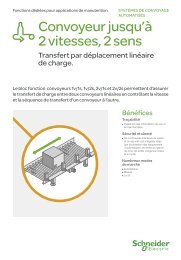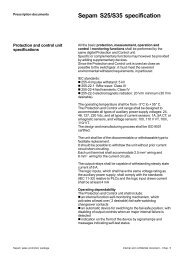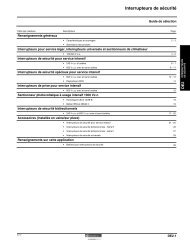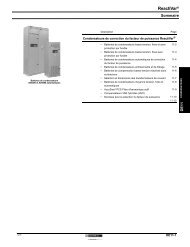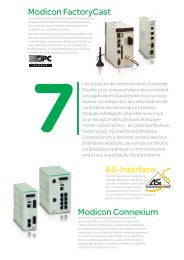Schneider Electric and the Carbon Disclosure Project
Schneider Electric and the Carbon Disclosure Project
Schneider Electric and the Carbon Disclosure Project
You also want an ePaper? Increase the reach of your titles
YUMPU automatically turns print PDFs into web optimized ePapers that Google loves.
<strong>Carbon</strong>e <strong>Disclosure</strong> <strong>Project</strong> Questionnaire<br />
May 2008<br />
<strong>Schneider</strong> <strong>Electric</strong> – Sustainable Development direction – 05/30/08 1
Risks <strong>and</strong> opportunities<br />
Risks<br />
1 How is your company exposed to regulatory risks related to climate change?<br />
As a manufacturer of electrical materials, <strong>Schneider</strong> <strong>Electric</strong> is not concerned by <strong>the</strong> emissions quotas set by <strong>the</strong><br />
national governments <strong>and</strong> <strong>the</strong> European Commission. <strong>Schneider</strong> <strong>Electric</strong> nei<strong>the</strong>r generates nor distributes<br />
electricity. Its business primarily relies on assembly <strong>and</strong> monitoring techniques <strong>and</strong> includes very few processes<br />
with a more significant environmental impact, such as metal processing <strong>and</strong> treatment. Our manufacturing <strong>and</strong><br />
logistics consume relatively little energy compared to cement works, glassworks, road <strong>and</strong> air transportation,<br />
electric generation, chemistry, aluminium or steel industry.<br />
O<strong>the</strong>r regulations regarding greenhouse gas reduction have to be applied by <strong>Schneider</strong> <strong>Electric</strong>:<br />
EU directive 2005/32/CE – so-called Energy Using Product directive - sets a framework for eco-design of<br />
energy consuming products. <strong>Schneider</strong> <strong>Electric</strong> has to apply this directive as a components supplier.<br />
EU directive 1999/13/CE aims at reducing <strong>the</strong> Volatile Organic Compounds (VOC) due to <strong>the</strong> use of<br />
organic solvents in some activities <strong>and</strong> industrial sites.<br />
Bylaw (CE) n°842/2006 by <strong>the</strong> European Parliament a nd Council on some greenhouse fluoridated gas (in<br />
particular regarding SF6).<br />
2 How is your company exposed to physical risks from climate change?<br />
<strong>Schneider</strong> <strong>Electric</strong> is not directly exposed to climate threats.<br />
Certainly, if climate changes dramatically in <strong>the</strong> years to come, we could have to cope with potential damages<br />
involving some of our 240 manufacturing <strong>and</strong> logistics sites all over <strong>the</strong> world. For instance sites located in <strong>the</strong> US<br />
Middle West could suffer from more tornadoes or our Indian sites from more droughts. However our industrial<br />
processes consume little water, <strong>and</strong> we need cooling system only for <strong>the</strong> comfort of our buildings<br />
Moreover, <strong>Schneider</strong> <strong>Electric</strong> has <strong>the</strong> ability to quickly move its facilities, since <strong>the</strong>y are relatively light structures<br />
<strong>and</strong> <strong>the</strong>y are not required to be close to specific raw materials. The Group has successfully implemented a<br />
relocation plan to manufacture closer to its markets (one of <strong>the</strong> essential objectives of our company program<br />
New² between 2005 <strong>and</strong> en 2008).<br />
3 How is your company exposed to general risks as a result of climate change?<br />
Clearly <strong>Schneider</strong> <strong>Electric</strong> directly emits little carbon in <strong>the</strong> atmosphere. We could have to support an energy bill<br />
increase <strong>and</strong> an impact of <strong>the</strong> likely increase in carbon cost (through transportation, or raw materials <strong>and</strong><br />
components). Thus we are <strong>and</strong> will be incited to save energy <strong>and</strong> reduce our carbon emissions. We include <strong>the</strong>se<br />
issues in our industrial strategy. However climate change is not a major risk for our company.<br />
4 Has your company taken or planned action to manage <strong>the</strong> general <strong>and</strong> regulatory risks <strong>and</strong>/or adapt<br />
to <strong>the</strong> physical risks you have identified?<br />
<strong>Schneider</strong> <strong>Electric</strong> respects regulations regarding global warming by implementing action plans with clear<br />
objectives.<br />
In 2007, <strong>Schneider</strong> <strong>Electric</strong> carried out a carbon assessment (so called Bilan <strong>Carbon</strong>e in France) so that <strong>the</strong><br />
Group could base its strategic decisions on both business <strong>and</strong> environmental indicators (Cf. Part II: GHG<br />
Emissions Accounting). After this first step, <strong>the</strong> Group has set <strong>the</strong> following action plan in 2008:<br />
• An additional study of carbon emissions from recycling of <strong>Schneider</strong> <strong>Electric</strong> products;<br />
• A business <strong>and</strong> environmental improvement plan for all of <strong>Schneider</strong> <strong>Electric</strong>’s supply chain activities;<br />
• Directives on business trips <strong>and</strong> alternative ways of meeting using communication technologies such as<br />
video or telephone conferences.<br />
Moreover we think about integrating carbon management in our company program to be set up by end 2008.<br />
<strong>Schneider</strong> <strong>Electric</strong> – Sustainable Development direction – 05/30/08 2
5 How do you assess <strong>the</strong> current <strong>and</strong>/or future financial effects of <strong>the</strong> risks you have identified <strong>and</strong> how<br />
those risks might affect your business?<br />
Our aim is to reduce <strong>the</strong> carbon intensity of our business by working on our supply chain. This work will<br />
contribute to decrease our dependence to fossil energies - that emit GHG <strong>and</strong> whom prices are expected to<br />
rocket in <strong>the</strong> future.<br />
However our customers are more concerned by risks as a result of climate change than we are. They consume<br />
energy 1- to make <strong>the</strong>ir machineries, data centres <strong>and</strong> motors work <strong>and</strong> 2- to warm up, light, air-condition <strong>the</strong>ir<br />
buildings. Consequently we propose solutions to our customers that respond to <strong>the</strong>ir urging need of energy<br />
efficiency <strong>and</strong> carbon reduction. Our business is dramatically changing towards those new services.<br />
Climate change is an enormous opportunity for our business, because energy efficiency <strong>and</strong> carbon<br />
reduction solutions will be pushed by constraints weighting on most energy-consuming <strong>and</strong> strongly emitting<br />
sectors, even in a context of an economic slowdown.<br />
Opportunities<br />
6 How do current or anticipated regulatory requirements on climate change offer opportunities for your<br />
company?<br />
Up to 50% of CO2 emissions attributable to residential <strong>and</strong> commercial buildings are from electricity consumption.<br />
Moreover, as domestic appliances, computers <strong>and</strong> entertainment systems proliferate <strong>and</strong> o<strong>the</strong>r equipment such<br />
as air conditioning <strong>and</strong> ventilation systems increase in use, electricity consumption is rising at a higher rate than<br />
o<strong>the</strong>r energy usage. However, in order to reach a 20% fall in consumption by 2020 <strong>the</strong> following has to happen:<br />
• All new buildings constructed consume 50% less energy;<br />
• 1 out of 10 existing buildings reduces consumption by 30% each year.<br />
As a result, governments apply an increasing regulatory pressure to meet <strong>the</strong>se ambitious targets. More<br />
dem<strong>and</strong>ing regulations will be enforced to address all energy uses, including existing buildings <strong>and</strong> industry.<br />
Regulations impose energy performance st<strong>and</strong>ards, such as:<br />
• Europe: <strong>the</strong> Energy Performance of Buildings Directive is expected to reach 28% energy savings in <strong>the</strong><br />
building sector – which means a 11% reduction in <strong>the</strong> total EU final energy consumption. O<strong>the</strong>r directives:<br />
EU Directive 2002/91/EC on <strong>the</strong> energy performance of buildings <strong>and</strong> <strong>the</strong> Directive on energy end-use<br />
efficiency <strong>and</strong> energy services (2006/32/EC) which fixes a requirement in terms of energy savings <strong>and</strong><br />
asks that member states take measures to achieve <strong>the</strong>ir respective targets;<br />
• France: following <strong>the</strong> “Grenelle de l’Environnement”, <strong>the</strong> government works on new measures to develop<br />
high energy efficient buildings: streng<strong>the</strong>ning <strong>the</strong> Energy Performance Diagnosis <strong>and</strong> Energy Economy<br />
Certificates (to facilitate financing of energy reduction works), increasing bonus for high energy efficient<br />
buildings, developing taxes to reduce energy consumption, etc.<br />
• United States: Energy Policy Act (2005), Building Codes, Energy Codes, State Energy program, Energy<br />
Conservation for Consumer Goods;<br />
• China: top 1000 Industrial Energy Conservation Program, China Energy Conservation Law, China<br />
Architecture law (EE in Buildings), China Renewable Energy Law.<br />
<strong>Schneider</strong> <strong>Electric</strong> highly commits in <strong>the</strong> promotion <strong>and</strong> sale of energy efficiency solutions for buildings.<br />
This regulatory context is a great opportunity for <strong>Schneider</strong> <strong>Electric</strong>.<br />
<strong>Schneider</strong> <strong>Electric</strong> is not directly concerned by <strong>the</strong> European Union’s ETS (emissions quotas, white certificates or<br />
domestic projects) <strong>and</strong> cannot easily be granted carbon credits for our EE solutions as several intermediaries<br />
operate on a building or renovation project (architects, contractors, engineering firms, etc.).<br />
7 How do current or anticipated physical changes resulting from climate change present opportunities<br />
for your company?<br />
N/A<br />
<strong>Schneider</strong> <strong>Electric</strong> – Sustainable Development direction – 05/30/08 3
8 How does climate change present general opportunities for your company?<br />
Climate change requires human beings to modify <strong>the</strong>ir production <strong>and</strong> consumption patterns: companies have 1-<br />
to propose low carbon solutions to <strong>the</strong>ir customers, <strong>and</strong> 2- to reduce <strong>the</strong> carbon intensity of <strong>the</strong>ir own activity:<br />
1. <strong>Schneider</strong> <strong>Electric</strong> commits to reduce its customers’ emissions (=energy supplied through our products). Now<br />
up to 30% savings are possible through a combination of efficient devices <strong>and</strong> installation (10 to 15%),<br />
optimized usage of installation <strong>and</strong> devices (5 to 15%) <strong>and</strong> permanent monitoring <strong>and</strong> improvement program<br />
(2 to 8%). Since 2004, energy efficiency has become key in <strong>the</strong> Group’s development strategy: its energy<br />
efficiency solutions have counted for 20% of its turnover in 2007 with a 15% growth. It has adopted a<br />
comprehensive energy strategy thanks to products <strong>and</strong> solutions that reduce consumption, optimize utility<br />
costs <strong>and</strong> improve reliability <strong>and</strong> availability. In our four-step approach for energy efficiency, we:<br />
• Fix <strong>the</strong> basics (low consumption devices, insulation material, power quality…);<br />
• Measure energy use to identify potential savings <strong>and</strong> dysfunctions;<br />
• Install low-consumption equipment <strong>and</strong> systems;<br />
• Improve long-term use by deploying automation management, consulting, training <strong>and</strong> tracking resources<br />
while maintaining high performance.<br />
2. <strong>Schneider</strong> <strong>Electric</strong> has set an objective to reduce energy consumption per production site employee by 10%<br />
by <strong>the</strong> end of 2008. We apply our solutions in our own operations through <strong>the</strong> “Energy Action” program to<br />
reduce consumption. It enables <strong>the</strong> Group to reduce its energy bill, <strong>and</strong> demonstrate our abilty to customers<br />
<strong>and</strong> stakeholders.<br />
9 Do you invest in, or have plans to invest in products <strong>and</strong> services that are designed to minimize or<br />
adapt to <strong>the</strong> effects of climate change?<br />
Investment in Energy Efficiency (EE)<br />
Cf former question.<br />
<strong>Schneider</strong> <strong>Electric</strong> has acquired companies specialised in energy efficiency for a few years – such as TAC in<br />
2003.<br />
Our R&D teams also focus on efficiency energy management, i.e. <strong>the</strong> ability to measure, optimize <strong>and</strong> supervise<br />
electricity use. Thus <strong>Schneider</strong> <strong>Electric</strong> is <strong>the</strong> leader of <strong>the</strong> European HOMES residential energy efficiency<br />
program. It aims at organizing a building like a smart, networked system to reduce energy consumption by 10% to<br />
30% <strong>and</strong> optimize comfort.<br />
Investment in renewable energies<br />
<strong>Schneider</strong> <strong>Electric</strong> has created in 2007 a Business Unit dedicated to renewable energies. It develops a range of<br />
photovoltaic UPS systems <strong>and</strong> collaborates with Solaire Direct, a company that installs residential photovoltaic<br />
panels <strong>and</strong> builds PV solar power plants. Renewable energies are expected to account for 13% of electricity<br />
generation in 2030.<br />
The Group is also developing <strong>the</strong> use of renewable energies in its own infrastructure. For example, <strong>the</strong> corporate<br />
restaurant at <strong>the</strong> Electropole R&D Center in Eybens, France is powered by solar energy. The European Operating<br />
Division’s headquarters in Barcelona, Spain is equipped with a photovoltaic system <strong>and</strong> a centralized HVAC<br />
solution that reduces energy costs by 15%. And <strong>the</strong> Group’s future headquarters under construction in Rueil-<br />
Malmaison will comply with France’s HQE green building st<strong>and</strong>ards, notably as concerns energy consumption<br />
(target: less than 50 kWh per square meter per year).<br />
Princess Elisabeth research station: Working in partnership with <strong>the</strong> International Polar Foundation, <strong>Schneider</strong><br />
<strong>Electric</strong> is providing electrical distribution, building management <strong>and</strong> remote control solutions for <strong>the</strong> Princess<br />
Elisabeth research station in Antarctica.<br />
The station, which is currently under construction, is unique in that it uses only renewable energy sources. These<br />
include solar energy, harnessed by photovoltaic <strong>and</strong> <strong>the</strong>rmal panels, <strong>and</strong> wind generators. As a result, <strong>the</strong> station<br />
will not emit any CO2 into <strong>the</strong> atmosphere. <strong>Schneider</strong> <strong>Electric</strong>’s participation in this exceptional adventure<br />
includes <strong>the</strong> entire station’s electrical supply, as well as building management (systems to control temperature,<br />
air, pump motors <strong>and</strong> mixers), <strong>and</strong> remote control for four months out of <strong>the</strong> year. Given <strong>the</strong> site’s violent winds,<br />
extreme temperatures (-40°C) <strong>and</strong> use of embedded te chnologies, our products <strong>and</strong> solutions will have an<br />
unprecedented opportunity to demonstrate <strong>the</strong>ir quality <strong>and</strong> reliability.<br />
<strong>Schneider</strong> <strong>Electric</strong> Ventures: this fund with a capital of €50 million aims at acquiring interests in innovative startups,<br />
in particular in renewable energies or energy efficiency technologies.<br />
<strong>Schneider</strong> <strong>Electric</strong> – Sustainable Development direction – 05/30/08 4
Examples of investments in emerging markets in 2007 included:<br />
• Solaire Direct, <strong>the</strong> first electric company in France fully dedicated to solar power. Solaire Direct builds PV<br />
solar power plants <strong>and</strong> installs residential photovoltaic panels.<br />
• Consumer Power Line, a US-based company that helps infrastructure managers reduce electricity dem<strong>and</strong><br />
during peak periods <strong>and</strong>, when possible, re-sell unused amounts at above-market prices.<br />
10 How do you assess <strong>the</strong> current <strong>and</strong>/or future financial effects of <strong>the</strong> opportunities you have identified<br />
<strong>and</strong> how those opportunities might affect your business?<br />
Energy is facing a critical dilemma: <strong>the</strong> power consumption will double by 2050 with <strong>the</strong> increase of world<br />
population <strong>and</strong> <strong>the</strong> CO2 emissions will have to be divided by 2 in <strong>the</strong> same time to avoid dramatic climate<br />
changes (according to <strong>the</strong> Intergovernmental Panel on Climate Change). We must learn to adapt <strong>and</strong> manage<br />
energy consumption to achieve this factor 4.<br />
<strong>Schneider</strong> <strong>Electric</strong> is involved in ¾ of end user energy consumption: electricity <strong>and</strong> fuel main sources are in<br />
buildings <strong>and</strong> industry for heating, motors, lighting, electronics <strong>and</strong> appliances.<br />
Energy efficiency is a must, better than new capacity because it is…<br />
• Cheaper: each kWh saved avoids about 3 times <strong>the</strong> generation production & dem<strong>and</strong> response programs<br />
cost about 2 to 3 cents/kWh, about half of typical electricity costs.<br />
• Quicker: technology available today with short term investment <strong>and</strong> short term results.<br />
• Cleaner: “negawatt” produces no environmental footprint.<br />
• Security enhancing: EE is homegrown, it reduces dependence on imports.<br />
Energy Efficiency solutions have already been a strong market opportunity for <strong>Schneider</strong> <strong>Electric</strong> <strong>and</strong> will continue<br />
in <strong>the</strong> future. We realised a €3,4 billion turnover in 2007 with EE products <strong>and</strong> solutions (20% of orders, +15%<br />
growth vs 2006).<br />
<strong>Schneider</strong> <strong>Electric</strong> – Sustainable Development direction – 05/30/08 5
GHG emissions accounting<br />
a Accounting Parameters<br />
<strong>Schneider</strong> <strong>Electric</strong> <strong>and</strong> its units worldwide are not required to hold CO2 emission permits. Never<strong>the</strong>less, a world<br />
leader like <strong>Schneider</strong> <strong>Electric</strong> who has taken determined steps to optimize energy efficiency <strong>and</strong> underst<strong>and</strong> <strong>the</strong><br />
planet’s great new societal <strong>and</strong> environmental challenges felt compelled to be fully transparent about its own<br />
carbon emissions.<br />
Even though its industrial processes do not consume huge amounts of energy, <strong>the</strong> Group wanted to carry out a<br />
carbon audit covering its own emissions, as well as those of suppliers, supply chain <strong>and</strong> o<strong>the</strong>r partners so that it<br />
could base its strategic decisions on both business <strong>and</strong> environmental indicators.<br />
To be sure, a forward-looking approach is all <strong>the</strong> more necessary in today’s environment of sharply fluctuating<br />
energy costs, as experts are now confirming <strong>the</strong> direct relationship between carbon emissions <strong>and</strong> <strong>the</strong> amount<br />
<strong>and</strong> type of energy consumed.<br />
What’s more, by putting itself through <strong>the</strong> audit process, <strong>Schneider</strong> <strong>Electric</strong> can also gain a better underst<strong>and</strong>ing<br />
of <strong>the</strong> issues <strong>and</strong> factory floor reality encountered by its large energy-consuming customers.<br />
11 Reporting boundary<br />
<strong>Schneider</strong> <strong>Electric</strong>’s carbon audit covers:<br />
• All of its suppliers.<br />
• The internal supply chain.<br />
• The upstream <strong>and</strong> downstream supply chains.<br />
• Management of all buildings.<br />
• All business trips.<br />
• The Group’s general operations.<br />
12 Reporting year<br />
Reference year: 2006<br />
This reporting period conforms to <strong>Schneider</strong> <strong>Electric</strong>’s financial reporting year.<br />
13 Methodology<br />
The method used corresponds to version 4 of <strong>the</strong> French Agency for Environment <strong>and</strong> Energy Management’s<br />
carbon audit. This method is compatible with <strong>the</strong> ISO 14 064 norm, <strong>the</strong> GHG Protocol <strong>and</strong> <strong>the</strong> terms of <strong>the</strong><br />
European directive n° 2003/87/CE on <strong>the</strong> tradeable C O2 emissions quotas.<br />
A vast, more than 8-month formalization program involving purchasing, supply chain, accounting, manufacturing<br />
<strong>and</strong> <strong>the</strong> Group’s environmental managers was required to obtain <strong>the</strong> final results.<br />
b Direct <strong>and</strong> indirect emissions – scope 1 <strong>and</strong> 2 of <strong>the</strong> GHG Protocol<br />
14 Are you able to provide a breakdown of your direct <strong>and</strong> indirect emissions under Scopes 1 <strong>and</strong> 2 1 of<br />
<strong>the</strong> GHG Protocol <strong>and</strong> to analyse your electricity consumption?<br />
Scope 1 (emissions related to our internal processes in 2006): 0,09 million of tonnes CO 2-e<br />
Scope 2 (emissions related to our internal energy consumption in 2006, ie machineries <strong>and</strong> buildings): 0,42<br />
million of tonnes CO 2-e<br />
1 Scope 1: direct emissions from GHG sources owned or controlled by <strong>the</strong> company, such as combustion facilities, combustion<br />
of fuels in company-owned or company-controlled transportation <strong>and</strong> physical or chemical processes.<br />
Scope 2: indirect emissions caused through <strong>the</strong> company’s consumption of imported electricity, heat, cooling or steam.<br />
<strong>Schneider</strong> <strong>Electric</strong> – Sustainable Development direction – 05/30/08 6
<strong>Schneider</strong> <strong>Electric</strong>’s energy consumption in 2006 = 918,024 MWh-e<br />
Please note that <strong>the</strong> reporting boundary differs for accounting energy consumption. The energy consumption of<br />
manufacturing <strong>and</strong> logistics sites are assessed in our environmental reporting. In 2006, 184 responding sites were<br />
included in our reported scope.<br />
c O<strong>the</strong>r emissions – scope 3 of <strong>the</strong> GHG Protocol<br />
15 How do you identify <strong>and</strong>/or measure Scope 3 2 emissions?<br />
<strong>Schneider</strong> <strong>Electric</strong> has tracked business trips of its employees <strong>and</strong> an outside contractor monitors invoices to map<br />
out all shipments from start to finish (origin, destination, shipping method).<br />
Our total emissions represent around two million tons of carbon, <strong>the</strong> equivalent of 7,7 millions of tons CO 2-e. Half<br />
of <strong>the</strong>se emissions are related to component materials, a third to supply chain activities <strong>and</strong> <strong>the</strong> rest to energy<br />
used by business trips, manufacturing procedures <strong>and</strong> buildings. This amount rises by including <strong>the</strong> end-of-life of<br />
our products; actually some of our products contain SF6, a powerful GHG. Regarding products maintenance <strong>and</strong><br />
end-of-life, <strong>Schneider</strong> <strong>Electric</strong> already proposes recycling solutions, alone or with partners, in particular to avoid<br />
SF6 gas leakages into <strong>the</strong> atmosphere, <strong>and</strong> plans to spread this offer to all of <strong>the</strong> countries where we operate.<br />
d External verification<br />
16 Has <strong>the</strong> information reported been externally verified or audited or do you plan to have <strong>the</strong><br />
information verified or audited?<br />
CO2 emitted by our industrial sites have been audited each year since 2005 by Statutory Auditors (please refer to<br />
<strong>Schneider</strong> <strong>Electric</strong>’s 2007 Annual Report, page 100, to get <strong>the</strong> verification statement).<br />
The calculation of our global CO2 emissions (Bilan <strong>Carbon</strong>e) has been carried out by an external agency<br />
specialised in carbon audit (Manicore).<br />
e Data accuracy<br />
17 Does your company have a system in place to assess <strong>the</strong> accuracy of GHG emissions inventory<br />
calculation methods, data processes <strong>and</strong> o<strong>the</strong>r systems relating to GHG measurement?<br />
Cf question 13 (Accounting parameters / methodology).<br />
f Emissions history<br />
18 Do <strong>the</strong> emissions reported for your last accounting year vary significantly compared to previous<br />
years?<br />
<strong>Schneider</strong> <strong>Electric</strong> has carried out a comprehensive carbon audit for <strong>the</strong> first time last year. No major change in<br />
<strong>the</strong> business structure could have influenced carbon emission compared to previous years; it evolves basically<br />
more or less as <strong>the</strong> turnover growth.<br />
2 Scope 3: o<strong>the</strong>r indirect emissions that are a consequence of a company’s activities, but which arise from GHG sources that<br />
are owned or controlled by o<strong>the</strong>rs. Examples include emissions as a result of <strong>the</strong> extraction, manufacture <strong>and</strong> production of<br />
materials it has purchased, <strong>the</strong> transportation of purchased fuels or goods, <strong>the</strong> use of products <strong>and</strong> services it has sold, <strong>and</strong><br />
business travel <strong>and</strong> employee commuting in vehicles not owned or controlled by <strong>the</strong> company.<br />
<strong>Schneider</strong> <strong>Electric</strong> – Sustainable Development direction – 05/30/08 7
g Emissions trading<br />
19 Does your company have facilities covered by <strong>the</strong> EU Emissions Trading Scheme?<br />
No.<br />
20 What is your company’s strategy for trading or participating in regional <strong>and</strong>/or international trading<br />
schemes (eg: EU ETS, RGGI, CCX) <strong>and</strong> Kyoto mechanisms such as CDM <strong>and</strong> JI projects?<br />
<strong>Schneider</strong> <strong>Electric</strong>’s facilities are too small <strong>and</strong> consume too little energy to be concerned by trading schemes <strong>and</strong><br />
Kyoto mechanisms.<br />
h Energy costs<br />
21 Please identify <strong>the</strong> total costs in US$ of your energy consumption eg from fossil fuels <strong>and</strong> electric<br />
power.<br />
<strong>Schneider</strong> <strong>Electric</strong> reports a global consumption (electricity, gas, fuel, gasoil, heat) of 981 000 MWh equivalent in<br />
<strong>the</strong> industrial <strong>and</strong> logisitics perimeter. Taking into account commercial <strong>and</strong> administrative buildings, it could be<br />
estimated at 1 300 000 MWh.<br />
Assuming a cost of 0.07€ per kWH (by excess), <strong>the</strong> annual cost rises to 91 M€.<br />
22 What percentage of your total operating costs does this represent?<br />
Around 2%.<br />
23 What percentage of energy costs are incurred on energy from renewable resources?<br />
It is to be underlined that:<br />
• our energy consumption is by 2/3 from electricity;<br />
• a significant part of our operations is still based in France;<br />
• <strong>and</strong> electricity in France is from nuclear origin for more than 80% <strong>and</strong> from hydraulic for 15 to 18%.<br />
<strong>Schneider</strong> <strong>Electric</strong> – Sustainable Development direction – 05/30/08 8
Performance<br />
Reduction plans<br />
24 Does your company have a GHG emissions reduction plan in place?<br />
In 2008, <strong>Schneider</strong> <strong>Electric</strong> has foreseen to implement <strong>the</strong> following actions:<br />
• An additional study of carbon emissions from recycling of <strong>Schneider</strong> <strong>Electric</strong> products;<br />
• A business <strong>and</strong> environmental improvement plan for all of <strong>Schneider</strong> <strong>Electric</strong>’s supply chain activities;<br />
• Directives on business trips <strong>and</strong> alternative ways of meeting using communication technologies such as<br />
video or telephone conferences.<br />
• A program so called <strong>Schneider</strong> Energy Action to reduce direct energy consumption by 10% over 3 years<br />
(2005 -2008). This goal has been reached as soon as <strong>the</strong> second year of <strong>the</strong> program.<br />
25 What is <strong>the</strong> baseline year for <strong>the</strong> emissions reduction plan?<br />
2007. For energy consumption: 2005.<br />
26 What are <strong>the</strong> emissions reduction targets <strong>and</strong> over what period do those targets extend?<br />
The definition <strong>and</strong> implementation of our carbon reduction plan are currently in progress, <strong>and</strong> will be defined by<br />
<strong>the</strong> end of 2008 in <strong>the</strong> framework of <strong>the</strong> new Company Program that will follow <strong>the</strong> current one New2.<br />
27 What activities are you undertaking to reduce your emissions? What targets have you set for each<br />
<strong>and</strong> over what timescales do <strong>the</strong>y extend?<br />
The company achieved following objectives in 2007:<br />
• measure its carbon footprint (first time ever);<br />
• deploy <strong>the</strong> United Nations Global Compact programme to each of its key transportation suppliers;<br />
• systematically ask suppliers to provide <strong>the</strong>ir strategy in terms of sustainable development in all <strong>the</strong> Request<br />
For Quotations (RFQ);<br />
• appoint an Executive Committee member, M. Hal Grant, as a point of contact for <strong>Carbon</strong> Footprint<br />
initiatives <strong>and</strong> a person in charge of implementing pilot projects to test alternative shipping system (rail,<br />
barge, short sea, etc.).<br />
Moreover, <strong>Schneider</strong> <strong>Electric</strong>’s units focused in 2007 on streamlining <strong>the</strong> supply chain, a clear source of carbon<br />
emissions. To address this issue:<br />
• a dedicated global corporate team was set up to get an overall view of international air <strong>and</strong> sea shipments,<br />
optimize purchasing <strong>and</strong> shift air freight towards sea shipments;<br />
• a plan to optimize pan-European flows was to devised to make road haulage more effective, notably by<br />
improving <strong>the</strong> truck fill rate;<br />
• an outside contractor monitored invoices to map out all shipments from start to finish (origin, destination,<br />
shipping method). A pilot program is under way in France <strong>and</strong> Spain, with <strong>the</strong> goal of deploying across<br />
Europe in 2008.<br />
In terms of target, <strong>the</strong> company:<br />
• commits to measure 90% of our transportation costs by 2012 through our Freight Cost Management<br />
system feeding a worldwide datacube with each individual shipment characteristics (mode of transportation,<br />
weight, mode of transport, origin <strong>and</strong> destination). This worldwide database can in turn measure our CO²<br />
contribution;<br />
• commits to reduce its reliance to airfreight by 50% in costs by 2012.<br />
28 What investment has been or will be required to achieve <strong>the</strong> targets <strong>and</strong> over what time period?<br />
Targets described above have to be achieved in 2012.<br />
<strong>Schneider</strong> <strong>Electric</strong> – Sustainable Development direction – 05/30/08 9
29 What emissions reductions <strong>and</strong> associated costs or savings have been achieved to date as a result<br />
of <strong>the</strong> plan?<br />
The definition <strong>and</strong> implementation of our carbon reduction plan are currently in progress.<br />
Emissions intensity<br />
30 What is <strong>the</strong> most appropriate measurement of emissions intensity for your company?<br />
The most appropriate measurement is our “direct” emissions:<br />
• Tonnage <strong>and</strong> transportation distance of raw materials, components <strong>and</strong> products, for 1€ of turnover;<br />
• Direct energy consumption <strong>and</strong> origin (electricity, oil, gaz, renewable), for 1 person or 1€ of turnover.<br />
31 Please state your GHG emissions intensity in terms of total tonnes of CO2-e reported under Scope 1<br />
<strong>and</strong> Scope 2 per $m turnover <strong>and</strong> EBITDA for <strong>the</strong> reporting year.<br />
Scope 1 (emissions related to our internal processes in 2007) = 5,2t CO 2-e per €m turnover; 29t CO 2-e per €m<br />
EBITDA 3 .<br />
Scope 2 (emissions related to our internal energy consumption in 2007, ie machineries <strong>and</strong> buildings) = 24t CO 2-e<br />
per €m turnover; 135t CO 2-e per €m EBITDA.<br />
32 Does your company set emissions intensity targets?<br />
No.<br />
Planning<br />
33 Do you forecast your company’s future emissions <strong>and</strong>/or energy use?<br />
No.<br />
3 2007 turnover = 17 300 €m; 2007 EBITDA = 3 114 €m<br />
<strong>Schneider</strong> <strong>Electric</strong> – Sustainable Development direction – 05/30/08 10
Governance<br />
Responsibility<br />
34 Does a Board Committee or o<strong>the</strong>r executive body have overall responsibility for climate change?<br />
2 members of <strong>the</strong> executive committee have overall responsibility for climate change:<br />
• M. Eric Pilaud, Executive Vice President, Strategy, Customers <strong>and</strong> Technology – Services <strong>and</strong> <strong>Project</strong>s<br />
Business Unit, to whom Sustainable Development Division reports;<br />
• M. Hal Grant, Executive Vice President, Globalization & Industry. Hal Grant is sponsor of <strong>Schneider</strong><br />
<strong>Electric</strong>’s carbon reduction plan.<br />
35 What is <strong>the</strong> mechanism by which <strong>the</strong> Board or o<strong>the</strong>r executive body reviews <strong>the</strong> company’s progress<br />
<strong>and</strong> status regarding climate change?<br />
Our program “Energy Action” is reviewed every year in our Planet & Society barometer (objective to reduce<br />
energy consumption per production site employee by 10% by <strong>the</strong> end of 2008).<br />
Our carbon reduction plan will also be reviewed thanks to regular targets reporting.<br />
Individual performance<br />
36 Do you assess or provide incentive mechanisms for individual management of climate change issues<br />
including attainment of GHG targets?<br />
No<br />
Communications<br />
37 Please indicate whe<strong>the</strong>r you publish information about <strong>the</strong> risks <strong>and</strong> opportunities presented to your<br />
company by climate change, details of your GHG emissions <strong>and</strong> plans to reduce emissions through<br />
any of <strong>the</strong> following communications<br />
Annual Report <strong>and</strong> voluntary communications such as CSR reporting: information on our 2007 carbon audit <strong>and</strong><br />
2008 carbon reduction plan has been published in our 2007 Annual Report (<strong>Schneider</strong> <strong>Electric</strong> has merged its<br />
CSR reporting <strong>and</strong> financial Annual Report).<br />
Formal communications with shareholders or external parties: <strong>Schneider</strong> <strong>Electric</strong> <strong>and</strong> its subsidiary TAC<br />
(specialised in automation in buildings) have adhered to <strong>the</strong> Clinton Climate Initiative in August 2007 to help<br />
cities around <strong>the</strong> world to improve energy efficiency in buildings <strong>and</strong> reduce greenhouse gas emissions.<br />
Public Policy<br />
38 Do you engage with policymakers on possible responses to climate change including taxation,<br />
regulation <strong>and</strong> carbon trading?<br />
No. But we take an active role in St<strong>and</strong>ardization at national, European (CEN – CENELEC) <strong>and</strong> international (ISO<br />
– IEC) levels in all <strong>the</strong>se matters.<br />
<strong>Schneider</strong> <strong>Electric</strong> – Sustainable Development direction – 05/30/08 11



